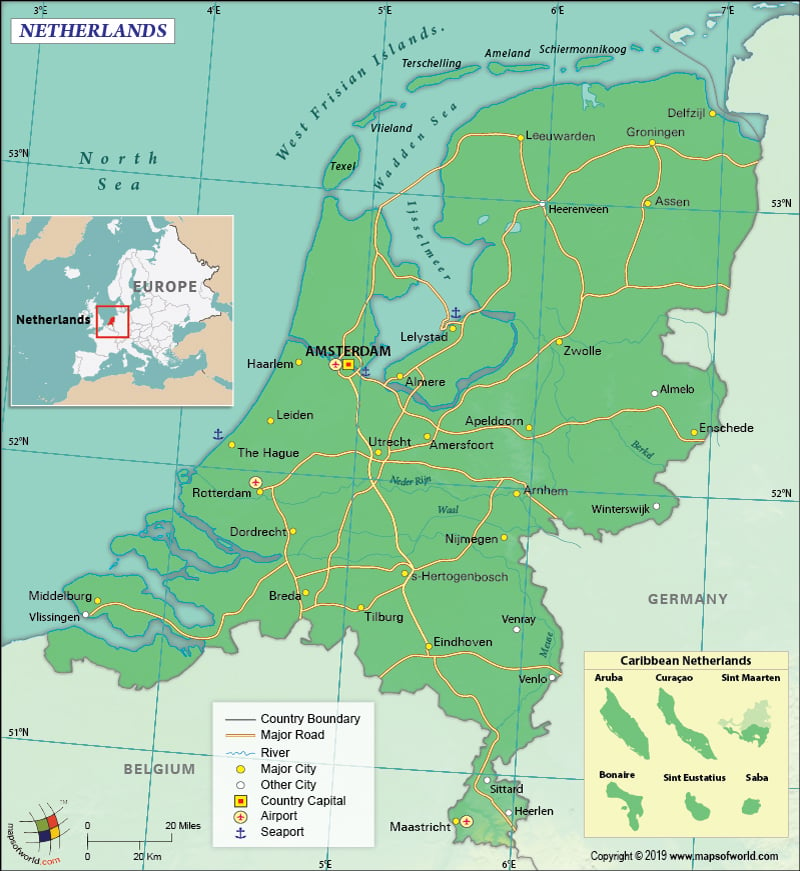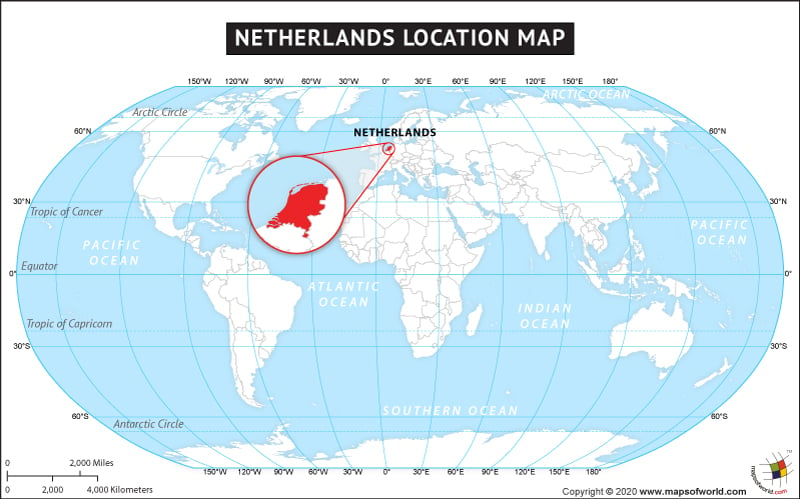What are the Key Facts of the Kingdom of the Netherlands?

|
Official Name |
Kingdom of the Netherlands |
|
Continent |
Europe, Caribbean |
|
Capital |
Amsterdam |
|
Largest City |
Amsterdam |
|
Coordinates |
52.500000, 5.750000 |
|
Area |
16,412 sq. mi ( 42,508 sq. km) |
|
Land Boundaries |
654 mi ( 1,053 km) |
|
Coastline |
280 mi ( 451 km) |
|
Currency |
Euro (€) (EUR), US dollar (in Caribbean Netherlands) |
|
Neighboring Countries |
Germany, Belgium |
|
Population |
17,336,891 (2019 est. ) |
|
Official Languages |
Dutch |
|
Major Religion |
Christianity |
|
National Day |
27 April (King’s Day) |
|
National Anthem |
“Het Wilhelmus” |
|
Form of Government |
Unitary parliamentary constitutional monarchy |
|
Monarch |
Willem-Alexander |
|
Prime Minister |
Mark Rutte |
|
GDP per capita (PPP) |
$ 56,328.9 (World Bank, 2018) |
|
GDP per capita (nominal) |
$ 53,024.1 (World Bank, 2018) |
|
HDI |
0.931 (2017), Rank: 10 |
|
Literacy Rate (%) |
NA |
|
Space Agency |
Netherlands Space Office |
|
Military Expenditure Ranking |
21 (SIPRI, 2017) |
|
No. of Olympic Medals |
416 (as of 2018) |
|
Driving Side |
right |
|
Calling Code |
+31 |
|
Time Zone |
UTC+1 (CET), Summer (DST) UTC+2 (CEST); Caribbean Netherlands: UTC−4 (AST) |
|
Internet TLD |
.nl |
Where is the Kingdom of the Netherlands?
The Netherlands is a Northwest European country that also has overseas territories (Sint Maarten, Curaçao, Aruba, Saba, Sint Eustatius, and Bonaire) in the Caribbean. In Europe, it is bordered by the North Sea to the northwest, Belgium to the south, and Germany to the east.
What is the Geography of the Kingdom of the Netherlands?
The Kingdom of the Netherlands (consisting of the Northwest European country called the Netherlands and overseas territories in the Caribbean) is spread across a total area of 42,508 sq. km (16,412 sq. mi).
The European part of the Kingdom of the Netherlands is spread across a total area of 41,543 sq. km (16,040 sq. mi), out of which 33,893 sq. km (13,086 sq. mi) is land area and 7,650 sq. km (2,954 sq. mi) is water area. It has a land boundary of 1,053 km (654 mi) long, which is shared with two countries: Germany (575 km or 357 mi) and Belgium (478 km or 297 mi). The Netherlands also has a coastline of 451 km (280 mi).
The Caribbean territories of the Kingdom of the Netherlands such as Curaçao is spread on 444 sq. km (171. sq mi), Bonaire on 294 sq. km (114 sq. mi), Aruba on 178.91 sq. km (69.08 sq. mi), Sint Maarten on 37 sq. km (14 sq. mi), Sint Eustatius on 21 sq. km (8 sq. mi), and Saba on 13 sq. km (5 sq. mi).
The Kingdom of the Netherlands has a mean elevation of 30 m (98 ft). While Mount Scenery (on the Saba island in the Caribbean) is the highest elevation point of the kingdom at 862 m (2,828 ft), Zuidplaspolder is the lowest elevation point at -7 m (-23 ft). However, Vaalserberg at 322 m (1,056 ft) is the highest elevation point of continental Netherlands.
The landscape of the Kingdom of the Netherlands is mainly flat and importantly 25% of the land is either at or below the level of the sea. The central area of the country consists of low rolling hills. The land rises into the Ardennes Mountains’ foothills in the far south. The West Frisian Islands are stretched along the northern coastline and continue in the northeast to become the German East Frisian Islands. The Waddenzee separates these barrier islands, thereby providing a bit of protection from the North Sea.
There are hundreds of miles of navigable canals situated in the Kingdom of the Netherlands. One such important canal is the North Sea Canal, which helps ships to reach the Amsterdam port. Some of the major rivers in the Kingdom of Netherlands are Mass, Rijn, Waal, and Scheldt. Two man-made large lakes are present in the country and they are Markermeer and Ijsselmeer.
There are two main zones in the Caribbean territories of the Kingdom of the Netherlands and all the islands have different terrains. The Leeward Islands consisting of Sint Maarten, Sint Eustatius, and Saba have a volcanic origin and the landscape is mainly hilly. There is hardly any landform available for agriculture. Another zone of Caribbean territories in the Kingdom of Netherlands is called the Leeward Antilles, which includes the islands of Curaçao, Bonaire, and Aruba. The island arc is formed along the Caribbean Plate’s (under the South American Plate) deformed southern edge.
The climatic condition of Netherlands’ Northwest European part has a temperate maritime climate, which is largely influenced by the Atlantic Ocean and the North Sea. While the winters are moderate, the summers are cool. In winter, the daytime temperature ranges within 2 °C (35.6 °F) and 6 °C (42.8 °F). In summer, the temperature ranges within 17 °C (62.6 °F) and 20 °C (68 °F).
The distribution of rainfall takes place throughout the year. However, April-September is the drier period of the year. Gales and uncomfortable weather can take place by the strong Atlantic low-pressure systems that prevail during winter and fall.
A more continental type of weather prevails in the European part of the Kingdom when the easterly winds blow in some parts of the country. The summers remain warm and dry. However, the winter season is cold and clear. The temperature plunges well below 0 °C (32 0 °F) during this climatic condition.
Often breezy conditions prevail in the majorly flat landscape of the Kingdom of the Netherlands. The breezy conditions are stronger in winter than in the summer. These conditions are more predominant along the coastal areas than inland.
A tropical climate persists in the Caribbean Islands and the weather remains warm throughout the year. The hurricanes often blow through the Leeward Islands, especially during summers.
What is the Economy of the Kingdom of the Netherlands?
The Kingdom of the Netherlands is one of the top-10 biggest economies of the European Union. It has come up as an important center of European transport. The economy of the Kingdom of the Netherlands is characterized by low unemployment, stable industrial relations, and consistently high trade value. The main industries here are based on electrical machinery, petroleum refining, chemicals, and food processing. The Netherlands is one of the top-5 countries in the world in terms of agricultural export.
The nominal GDP of the economy grew at 2.6% in 2018 to reach a figure of US$914,519 million. The main exports of the country are broadcasting equipment, crude/refined petroleum, human/animal blood, packaged medicaments, etc. The major imports of the Kingdom of the Netherlands are crude/refined petroleum, computers, office machine parts, broadcasting equipment, etc. In 2017, it had a US$23.4 billion of negative trade surplus as its value of export and import were US$461 billion and US$485 billion respectively.
The rate of unemployment has progressively decreased from 7.42% in 2014 to 3.88% in 2018. In September 2019, the unemployment rate was 4.2%. The Kingdom of the Netherlands has one of the lowest poverty rates in the entire Europe, which is hovering around 4.7% among families.
What is the Transportation System of the Kingdom of the Netherlands?
The Kingdom of the Netherlands has 139,124 km (86,447 mi) long roadways, out of which expressways are spread over 3,654 km (2,270 mi). There is a 6,237 km (3,875 mi) long waterway that can be navigated by ships that are up to 50 tons.
While Ijmuiden and Vlissingen are the main seaports, Terneuzen (Western Scheldt River), Rotterdam (Rhine River), Moerdijk (Hollands Diep River), and Amsterdam (Nordsee Kanaal) are the major river ports. Rotterdam is both an LNG terminal and a container port. Over 1,233 merchant marine vessels are there in the country, out of which 586 are general cargo, 41 are container ships, 13 bulk carriers, 21 oil tankers, and 572 others.
Over 3,058 km (1,900 mi) standard-gauge railway network is present in the Kingdom of the Netherlands. Moreover, there are over 29 airports in the country, out of which 23 have paved runways and 6 have unpaved runways. One heliport is present. Amsterdam Airport, Eindhoven Airport, Rotterdam The Hague Airport, Groningen Airport, Maastricht Airport, Flamingo Airport, and others are the main airports of the country.
What International Organizations is the Kingdom of the Netherlands part of?
UN, WTO, IMF, UNESCO, WHO, ILO, Interpol, Paris Club, Australia Group, Benelux, BIS, CD, CE, CERN, EAPC, EBRD, ECB, EIB, EMU, ESA, EU, FAO, FATF, G-10, IADB, IAEA, IBRD, ICAO, ICCT, ICRM, IDA, IEA, IFAD, IFC, IFRCS, IHO, IMO, IMSO, IOC, IOM, IPU, ISO, ITSO, ITU, MIGA, MINUSMA, NATO, NEA, NSG, OECD, OPCW, OSCE, PCA, Schengen Convention, UNCTAD, UNDOF, UNHCR, UNIDO, UNMISS, UNRWA, UNTSO, UNWTO, UPU, WCO, WIPO, WMO, ZC, ADB (nonregional member), AfDB (nonregional member), Arctic Council (observer), CBSS (observer), EITI (implementing country), ICC (national committees), IGAD (partners), ITUC (NGOs), OAS (observer), Pacific Alliance (observer), SELEC (observer)
Related Links:



